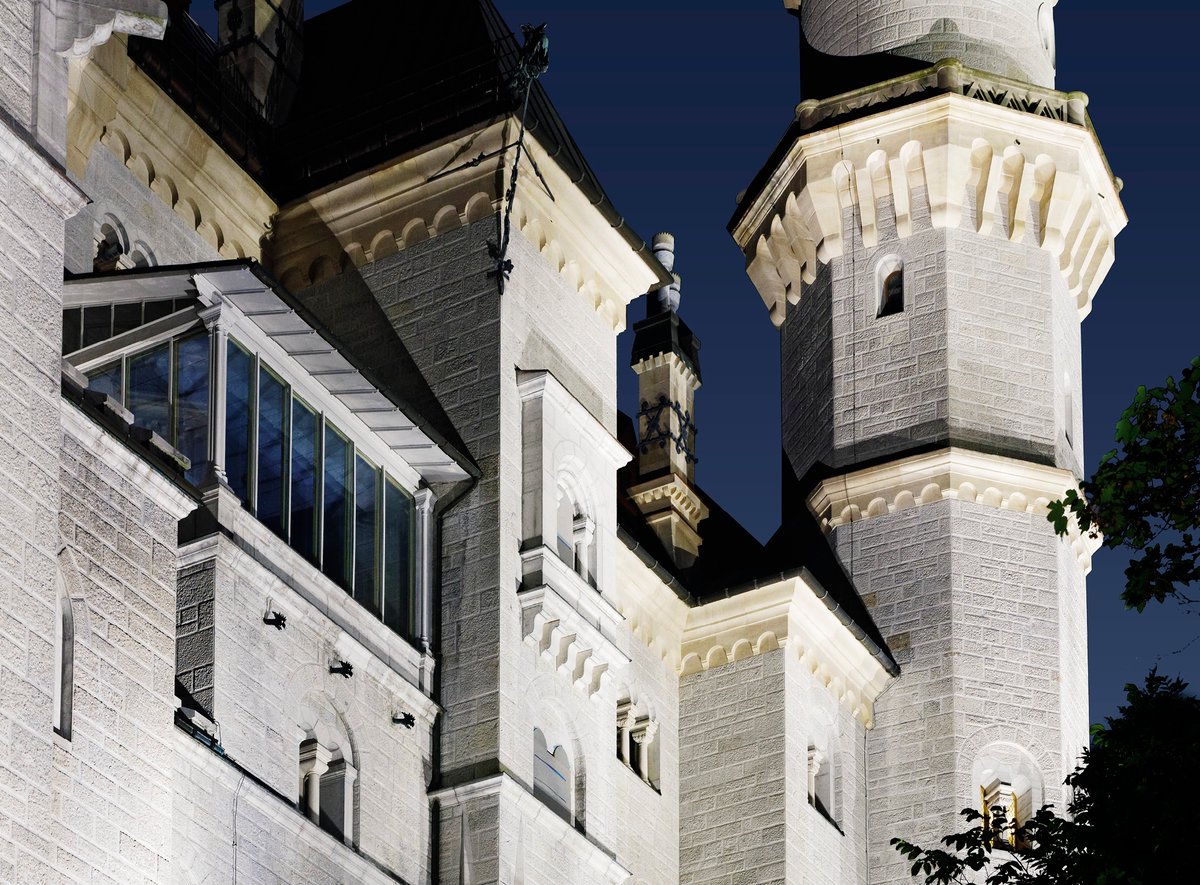
Germany’s most famous castle and monument fascinates and inspires people around the world. New lighting solutions highlight its many architectural details at night.
Germany’s fairytale castle – famous around the world: Neuschwanstein Castle in Bavaria is the incomplete architectural masterpiece of King Ludwig II. Originally used as a private retreat by its reclusive inventor and builder, the site is now a magnet for visitors. 1.5 million fascinated visitors per year step into the fairytale realm of the castle – that’s up to 10,000 people a day. Although not originally intended as a show of power, the castle is a breathtaking sight, even from many kilometres away. After dark, cleverly and thoughtfully placed lighting pays homage to this most famous monument in Germany.

Neuschwanstein Castle is unique in its impact on people: the castle has countless details, inspired by different cultures and building periods, to discover.
Lighting designer Walter Bamberger and his engineering firm conceptualised and implemented the new lighting design for the exterior of the fairytale castle. To achieve this, he set out to become intensely familiar with King Ludwig II and the history of the castle’s construction. “The intricacy and attention to detail of the architecture is both fascinating and challenging,” says Bamberger. “The big challenge was to come up with a lighting design that has the same impact on the observer from many kilometres away.”
When the decision was made to replace the old outdoor lighting from the 1980s (“It was just bright!”) with modern, energy-saving and insect-friendly LED light, the Bavarian Palace Administration ultimately rejected two already created lighting concepts – and recommended the firm of Walter Bamberger to the responsible municipality of Schwangau instead.
The specialist in special lighting scenarios was only satisfied with his design, which he said “should be more than just a mundane spotlight illumination”, on the second try. The engineering firm’s design earned admiration from the administrators of this architectural jewel.
Bamberger’s solution: To use light and shadow to their maximum effect and highlight the details, as though Neuschwanstein Castle were coated in a fine layer of icing. “It’s important to understand the philosophy of the castle, which was never really completed.”
A tower, which is reminiscent of a minaret and documents King Ludwig II’s enthusiasm for Ottoman culture, is part of a visual composition with elements of a medieval castle and the appearance of a Roman watchtower.
“We essentially deconstructed Neuschwanstein, with its many influences and angles, into its individual parts.”
Walter Bamberger, Lighting Designer

🔵 Luminaire pole with floodlights 1 Gatehouse 2 Square tower 3 Lower courtyard 4 Upper courtyard 5 Knight’s house 6 Ladies’ living quarters 7 Stair tower 8 Great hall

Distinctive images at night: the castle goes to sleep
In his design for the illumination of Neuschwanstein Castle, Walter Bamberger set out to “Find the architectural elements and make them stand out from the facade!” Targeted placement of shadows makes the castle look even more lifelike at night and from a greater distance. “We tried to find luminaires with the corresponding light distribution and output for every single angle and situation of the architecture, which was designed by King Ludwig himself,” explains Walter Bamberger. “We also broke down the lighting into single elements.”
To create spatial depth and a variety of luminous energy, the various BEGA floodlights provided just the right level of implementation. “We have played a lot with the BEGA portfolio and thoroughly shuffled it for the nighttime illumination of the castle,” says Walter Bamberger. Eleven different high-performance and compact floodlights light up Neuschwanstein Castle from a distance. The fact that the individual floodlights are available with different light distributions and light outputs helped implement Walter Bamberger’s concept for the world-famous castle with pinpoint precision.
“My motto was: the castle goes to sleep! I had never done anything like it before”
Walter Bamberger, Lighting Designer
But illuminating the castle’s unique features in their entirety was not the only challenge that presented itself after dark. Walter Bamberger experimented with a one-of-a-kind closing scenario at night: “The lights shouldn’t just go out,” explains the engineer. Just before 11 pm, the observer is shown a spectacle in which the middle elements of the castle are first to disappear into the night. The light is carefully dimmed before being extinguished. “After that, the two dominant towers appear from a distance as though they are two separate castles. It’s a very distinctive image,” remarks Walter Bamberger. After the final scenes in the performance, Neuschwanstein Castle finally goes to sleep for the night.
Underlying it all is the legend of this 19th-century masterpiece. Walter Bamberger gets to the heart of his fascination of Neuschwanstein Castle, saying: “To get the chance to work on such a famous building is something special, and makes us very proud.”




















